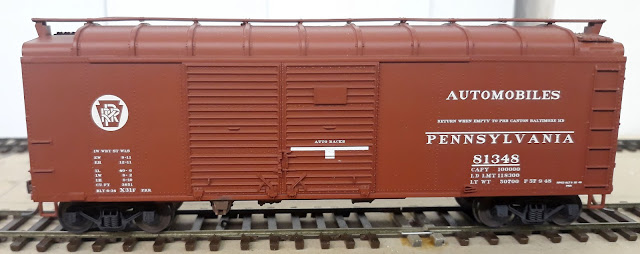The X31F class boxcars were rebuilt during the early days of WWII with the center portions of the roof raised to allow taller vehicle loading, such as stacking inclined jeeps, etc. These cars result in a very unique look in a regular freight train. Nearly 700 cars were rebuilt into this form, they certainly did make their way around the country after the war for a number of years.
According to the 1950 ORER there were still 457 cars in XMR (Note: A & E) service with fixed automobile racks which could be retracted into the roofs in the 81200-81889 series. In addition, 233 XM (Note: A & G) plain boxcars filled out the 81200-81889 series. See Notes E and G for exact car numbers for which AAR class car desired. This series filled number range, to-the-car, at the end of the X31A series below and butted right against the X41A series above.
PRR 81205 - XM (Plain boxcar)
 |
| PRR 81205, earlier Bowser X31F "Turtle Roof" boxcar, painted for general service |
One of my older X31F kits built up as a general service boxcar. The lettering for the "PENNSYLVANIA" seems incorrect compared to the 81348 (below) being a bit too large and tall, this seems to be fixed on the newer models. Decals from National Car Shops/ex-Speedwitch should be able to fix this, but would require repatching the paint before replacing the road name.
PRR 81348 - XMR (Auto-Rack)
My newer swap-meet bought unbuilt kit shows the car stenciled with "Return when empty to PRR Canton Baltimore MD" assignment stencil, which gives the car's home station. When the car returned to that station, the Freight Agent there would then assign the car to go to an auto assembly plant for loading. These cars were called "boarded empties" and would be returned directly by fastest route to the named station. Certain freight symbols were specifically indicated to handle high priority loads and these "boarded" empties to expedite their return for reloading.
 |
| Pennsy X31F class "Turtle Roof" automobile boxcar, newer Bowser kit version. |
Looking up in the notes, the PRR 81348 shouldn't have the racks fitted, per what the door marking says, in 1950. However, as the car's tare date shows the stenciled September 1948 date, it's possible the car was still assigned and fitted for automobile service with Evans racks.
 |
| B-end of Bowser X31F which needs the brake staff linkage fabricated. |
Like the other Bowser kits from this era, I'll be needing to fabricate a brake staff and bell crank for the handbrake.
 |
| Underframe with modified air reservoir position on the basic underframe. |
Underframe with air reservoir moved and turned 90 degrees from most other non-PRR cars. I may install some lead strips between the centersills to help the Center-of-Gravity moment on the car.
In Closing
 |
| X31F PRR 81209 XM in a string of interchange cars at Kern Jct., Jan 4, 1953 TT/TO Ops LMRC |
These cars of mine have provided some variation "Standard steel boxcar" look of the 1950s fleet at LMRC for most of 20-odd years in automobile service and auto-parts service in trains such as Santa Fe's 59, WGFX, and BK symbol freights, and regular transfers to the SP to connect to the Bay Area from Bakersfield on Altamont West (AW), returning on Altamont East (AE) symbols with auto-parts. Auto cars in general service showed up in other symbol freights such as: VXE, VXW, NCP, OCM, etc.
The newly built PRR 81348 and another sister X31F kit, yet to be assembled, will be available for service occasionally on the Jawbone Branch.
The newly built PRR 81348 and another sister X31F kit, yet to be assembled, will be available for service occasionally on the Jawbone Branch.
Jason Hill
Related Articles:
X31 & X32 Boxcars (Part 1) - NP Correction in Era - Correcting Bowser NP X31 & X32 class models.
X31 & X32 Boxcars (Part 2) - PRR X32A from Bowser Kits - Both plain and Evans Automobile cars from Bowser kits. Also Automobile and Auto-Parts History.


Was the White Stripe on the door an indicator of a specialized automobile service that was also used by other railroads. I've seen it on some other "Automobile" boxcars that had them.
ReplyDeleteYes, it means that the car is fitted with the auto racks to carry a second level of cars inside. Usually the railroads used the Evans auto rack system which was retractable into the roof or fixed racks where the upper rack couldn't be move up against the roof.
ReplyDelete